This was published 6 years ago
Mexico guide: Most popular destinations and why you should go
By Julie Miller
It's 8am at One and Only Palmilla, Los Cabos, Mexico, and I'm feeling a little guilty for leaving footprints on the freshly groomed playa, despite a reassuring wave from a tractor-driving employee hard at work ensuring no such scars mar the golden sand.
Meanwhile, a newlywed couple are having their own moment on the boulder-strewn beach, re-enacting the iconic From Here to Eternity movie scene – rolling in the breakers, lip-locked, under the watchful direction of a video production team.
Such is beach-life at one of Mexico's most exclusive resorts, the domain of billionaires, celebrities and cashed-up travellers prepared to spend top dollar for some old-school glamour. And why not? Los Cabos is undeniably beautiful, atmospheric and romantic – what more could you ask for in a honeymoon destination?
But hang on, isn't this the country American President Donald J. Trump wants to cut off with a border wall? The Mexico of "bad hombres", organised crime and illegal immigrants? The country he has maligned as "an enemy" and "not our friend, believe me"?
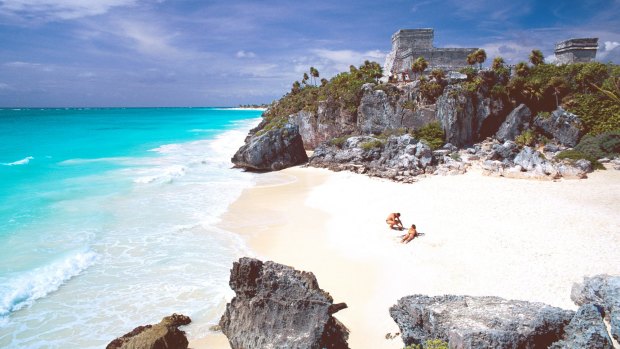
Mayan ruins overlooking the Caribbean Sea and beach at Tulum, Yucatan Peninsula.Credit: Alamy
Well, yes and no. Mexico does have its dangers, from a recent spate of natural disasters, to sobering statistics about cartel-related violence and homicide. And while tourist areas remain largely unaffected by serious crime, there are several no-go zones, with the Australian Government's Smartraveller website advising visitors to heed "a high degree of caution", particularly in border regions.
But that's not the side of Mexico most visitors experience. My Mexico is one of smiling faces, effusive hospitality and genuine, family-oriented warmth; and while due vigilance in public places is prudent, security is highly visible and targeted aggression thankfully rare.
In spite of bad press and Trump's demands for a wall, Mexico is fighting back, reclaiming their economic independence with a new wave of nationalism. Mexicans are rightfully proud of their history and culture, and have started a campaign promoting products made in Mexico, labelling all locally created crafts with an "Hecho en Mexico" sticker.
Indeed, there are just so many things to love about this land "south of the border" – its food, drink, music … all so rich, so delicious, affordable and individualistic. And the country's most celebrated icon, Frida Kahlo, was an intellectual, monobrowed, bisexual, communist artist
Then there are its landscapes: from glorious beaches to jungle, to colonial cities and a pulsating capital, to deserts that have inspired the Hollywood cowboy myths. For travellers thinking of exploring this intriguing, misunderstood country for the first time, here's a guide to its most popular destinations and what they offer.
Mexico City
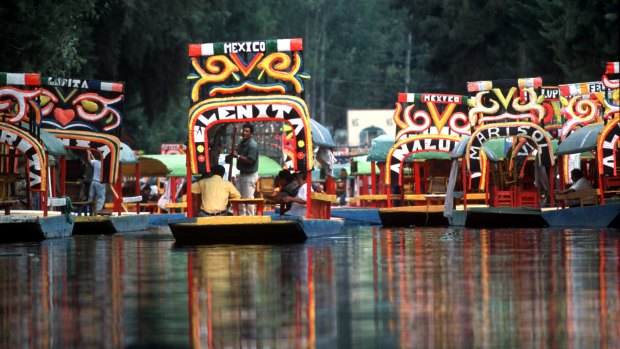
Credit: Alamy
WHERE IS IT Central Mexico, Mexico State.
WHY WE LOVE IT Vibrant, cosmopolitan city with great food, fabulous nightlife, lovely parks, world-class art museums and bargain shopping.
DON'T MISS The Saturday market at historic Coyoacan for local art, fashion, trinkets and atmosphere. While you're in the vicinity, pop into the Frida Kahlo Museum at Casa Azul (the Blue House) for an insight into the life of the enigmatic artist.
For kitsch touristy fun, take a gondola ride through the canals of Xochimilco, serenaded by mariachis; or for respite from the crowds, wander through enormous Chapultepec Park and its castle on the hill.
STAYING THERE The best little B&B in the world is Red Tree House in Condesa. Friendly, affordable, stylish and in a great location (fortunately unaffected by the recent earthquake). Book well in advance. See theredtreehouse.com
ESSENTIALS November to May are the driest, coolest months, with blue skies and temperate weather from March to May. Hold onto your belongings in public places; and beware of taxi scams – use official sitos, avoid taxi touts and note that even hotel concierges might be on the take. See visitmexico.com
Valle de Bravo
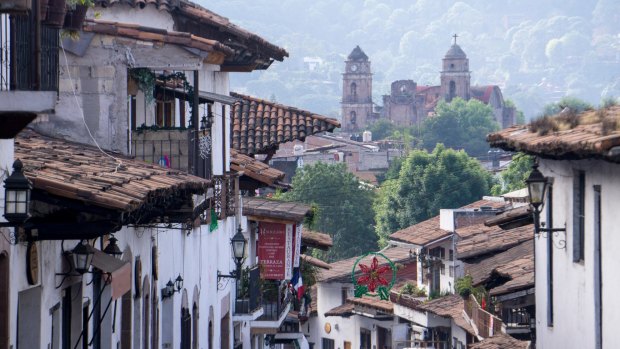
Credit: Alamy
WHERE IS IT Mexico State, 156 kilometres west of Mexico City.
WHY WE LOVE IT A picturesque colonial village – one of Mexico's pueblo magico (magical towns) – that springs to life on weekends when wealthy chilangos (Mexico City residents) escape the city.
DON'T MISS The zocalo after sunset, as locals converge to stroll, sip micheladas (beer spiked with chili) and listen to music. Valle de Bravo is one of the best places in the world for paragliding, with reliable thermals. For a surreal, ethereal experience, ride a pony to a nearby Monarch Butterfly sanctuary to witness one of the world's great migrations.
STAYING THERE Located on the shores of Lake Avandaro, Rodavento offers "glamping" in rustic bungalows, with many outdoor activities on offer. See hotelrodavento.com
ESSENTIALS Located in the mountains, Valle is usually several degrees cooler than Mexico City. November to April is a delightful time to visit. See visitmexico.com
Taxco
WHERE IS IT Central Mexico, 156 kilometres southwest of Mexico City.
WHY WE LOVE IT An authentic, perfectly preserved colonial city famed for its silver jewellery shops, dramatic hillside setting and distinctive architecture.
DON'T MISS The iconic twin-belfried Templo de Santa Prisca is one of Mexico's most beautiful buildings. There are reasonably priced silver shops all throughout the town; pay by weight and look for the engraving ".925" for authenticity.
STAYING THERE De Cantera y Plata offers boutique accommodation in a hacienda with amazing views of the city. See decanterayplata.com
ESSENTIALS The annual Feria de Plata (silver festival) is held in the last week of November. See visitmexico.com
Guanajuato
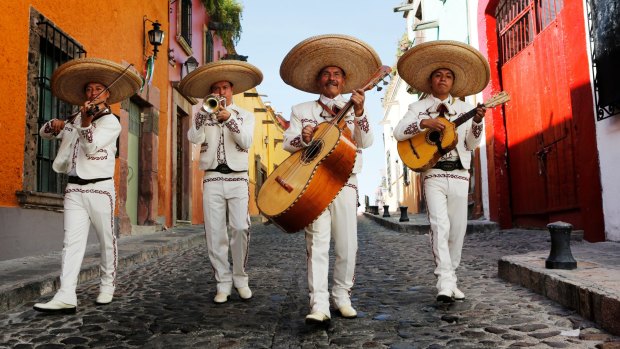
Credit: Alamy
WHERE IS IT Central Mexico, 466 kilometres northwest of Mexico City.
WHY WE LOVE IT Step back in time exploring the cobbled streets and tunnels of this atmospheric, culturally rich UNESCO World Heritage-listed Silver City.
DON'T MISS Just outside of town, the bizarre Mummy Museum displays corpses preserved by the high silver content in the soil – a surefire hit with teenage kids. Art lovers will appreciate the birthplace of Diego Rivera, which displays some of his early works.
STAYING THERE The iconic Villa Maria Cristina Hotel is a complex of stunning colonial mansions linked by gardens. See villamariacristina.net
ESSENTIALS Guanajuato's taxis aren't metered, so make sure you negotiate the price before you get in. The city enjoys year-round dry, temperate weather. See visitmexico.com
Los Cabos
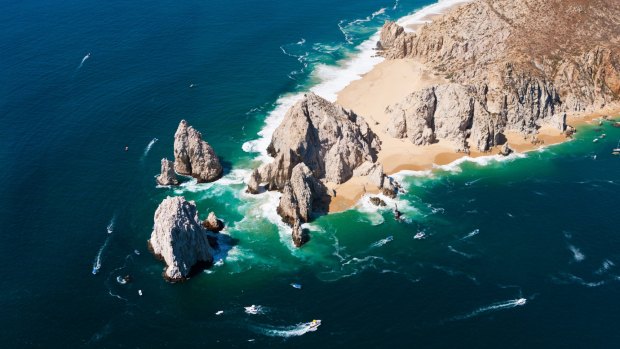
Credit: Alamy
WHERE IS IT The tip of the Baja Peninsula in Mexico's north-west, just a two-hour flight from Los Angeles.
WHY WE LOVE IT Dramatic "desert meets the sea" landscape, great weather and beautiful beaches combine for a perfect introduction to Mexico, with celebrity-style glamour in upmarket resorts thrown in for good measure.
DON'T MISS Stroll the historic centre of San Jose del Cabo during the Thursday night Art Walk. Take a cooking class at Flora Farm, an organic farm and kitchen serving produce straight from the garden. Visit Todos Santos, a colonial city and artistic hub 90 minutes north on the Pacific coast, designated one of Mexico's pueblo magicos,
STAYING THERE The Cape, a Thompson Hotel, is a contemporary, hip masterpiece, with every room boasting views of The Arch. See thompsonhotels.com
For old-school glamour, One and Only Palmilla is simply divine. See oneandonlyresorts.com
ESSENTIALS Hot, sunny and dry most of the year, though there are risks of hurricanes in September-October. Peak season from November to April. See visitloscabos.travel
Oaxaca City
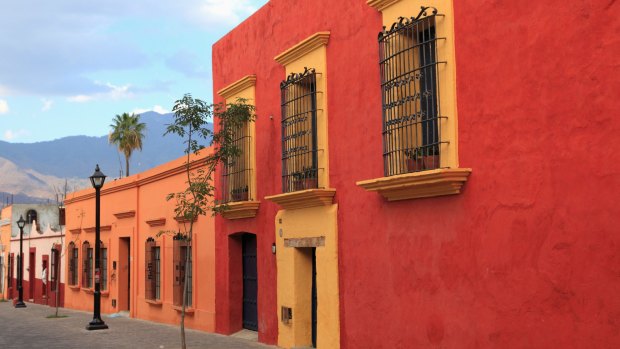
Credit: Alamy
WHERE IS IT South-western Mexico, inland from the Pacific Ocean and its laid-back beaches.
WHY WE LOVE IT Authentic Mexico at its most vibrant, rich with culture, history, art, architecture and one of the most exciting regional cuisines.
DON'T MISS The city features arguably the most photogenic zocalo in Mexico, lined with arcades, bars and cafes serving the regional speciality, grasshopper (chapulines). According to folklore, if you consume these crunchy insects, you'll return one day to Oaxaca! Visit the workshop of Jacobo and Maria Angeles in San Martin Tilcajete, producers of colourful fantasy wooden creatures (alebrijes); while the ruins of Monte Alban give an insight into the little-known Zapotec culture.
STAYING THERE Contemporary design meets tradition at Hotel Azul, built around two courtyards with a great central location. See hotelazuloaxaca.com
ESSENTIALS Although badly hit by a recent 8.1 earthquake, damage in the city centre was minimal and tourism remains unaffected. Spring (April-May) and autumn (September-October) are the best times to visit, with cool weather from November to March.
Tulum
WHERE IS IT Caribbean coast, Quintana Roo, two hours south of Cancun.
WHY WE LOVE IT Turquoise waters, blinding white sand, photogenic ruins, yoga, vegan food – the definition of bohemian chic.
DON'T MISS If you're going to see just one Mayan ruin in your lifetime, the cliff-top site at Tulum is the obvious choice, satisfying both historical curiosity and a sense of aesthetics. Plus, once you've explored, just walk down a few steps to the beach to cool off. You can also snorkel in dozens of nearby cenotes, natural limestone sinkholes with stunningly clear blue water.
STAYING THERE Eco-chic Coco Tulum is conveniently located between the northern and southern beaches, so you can ride bicycles to all the attractions. See cocotulum.com
ESSENTIALS The best months to visit Tulum are November and December, with peak season January-March. Hurricane season starts in June. See visitmexico.com
Isla Holbox
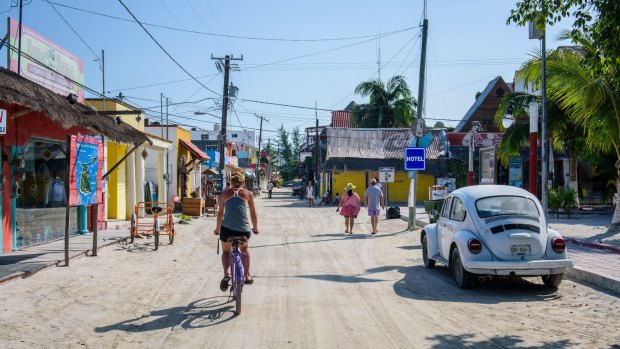
Credit: Alamy
WHERE IS IT Tip of the Yucatan Peninsula, two hours north of Cancun.
WHY WE LOVE IT Island life at its most idyllic – no cars, sandy roads, colourful buildings, hammocks slung over crystalline water, fresh ceviche and flamingos.
DON'T MISS Hire a golf buggy to explore the 30 kilometre-long island, stopping off at the Yum Balam Nature Reserve to spy a flamboyance of flamingos. The most famous natural residents of Holbox, however, are whale sharks, which congregate in nearby waters between June and September.
STAYING THERE CasaSandra is a boutique beachside hotel adorned with paintings by its Cuban artist owner. See casasandra.com
ESSENTIALS High season is June-September, because of the presence of whale sharks – but this is also rainy season, which brings swarms of mosquitoes. Arm yourself with good repellent – they are voracious! See holboxisland.com
TRIP NOTES
FLY
The most direct route to Mexico from eastern Australia is via Los Angeles, with connections to Mexico City, Los Cabos, Cancun and other Mexican destinations. No visa is required for Mexico, but make sure you have an ESTA or valid visa for the US, even if just transiting.
SPEND
The Mexican peso was trading, at the time of writing, at 14.41 MXN to $A1. US dollars are also accepted in many resort towns.
SPEAK
While you'll get by with English and tourist Spanglish in resort towns, most people in rural regions don't speak English, so it pays to have a smattering of Spanish.
RIDE
Mexico's long distance bus system is excellent – clean, safe and economical, with regular, reliable services. ADO services Central and southern Mexico, including the Riviera Maya. See ado.com.mx
EAT
Mexican street food is among the world's most delicious cheap eats – you'll never suffer another Old El Paso boxed taco again! While each region has its own gourmet specialities, popular national dishes include chicken mole (a sauce made from onions, garlic, chile and ground nuts, simmered with dark chocolate), chilaquiles (a spicy tortilla dish, often served with eggs for breakfast), enchiladas and tamales.
PREVENT
No special immunisations are required for Mexico, but make sure you're up to date with tetanus, Hep A and typhoid vaccinations. Mosquitoes can be a problem in tropical areas, but malaria, dengue fever and zika are low-risk. Prevention with tropical strength insecticide is recommended. The hospital system is excellent, and nowhere near as expensive as the US.
MORE
The writer travelled to Mexico as a guest of Los Cabos Tourism and at her own expense. See visitloscabos.travel
FIVE THINGS TRUMP (AND THE WORLD) SHOULD THANK MEXICO FOR
COWBOY CULTURE
The word "cowboy" is a direct translation of the Spanish word vaquero; not only were America's first ranch hands from Mexico, but everything we love about US cowboy culture harks from its Mexican origins – the clothing, horse-riding techniques and the vocabulary.
CHOCOLATE
The indigenous tribes of Mexico have grown cacao beans since at least 1750BC, primarily consuming the fermented and roasted pods as a hot, bitter drink. The Aztecs believed xocolatl was a gift from the god Quetzalcoatl, using it to purify before sacrifices, to cure ailments and as an aphrodisiac.
COLOUR TELEVISION
Couch potatoes the world over can thank Mexican engineer Guillermo Gonzalez Camarena, who patented the first colour television adaptor in 1941. His method was later developed in the US as the standard transmission system.
CHEWING GUM
For thousands of years, Mayans and Aztecs chewed the resin of the sapodilla tree (called chicle) to freshen breath and clean teeth. In the late 1800s, exiled Mexican president General Santa Anna introduced chicle to American inventor Thomas Adams, who hand-rolled it and added flavour to create the ubiquitous gum that plays havoc to soles of shoes.
AVOCADOS
Australians can credit our favourite breakfast smash (and the subsequent millennial housing crisis) to Mexico, with the super-fruit grown throughout Mesoamerica for 10,000 years.
CELEBRATION NATION: THE FIVE MUST-SEE FIESTAS IN MEXICO
DAY OF THE DEAD
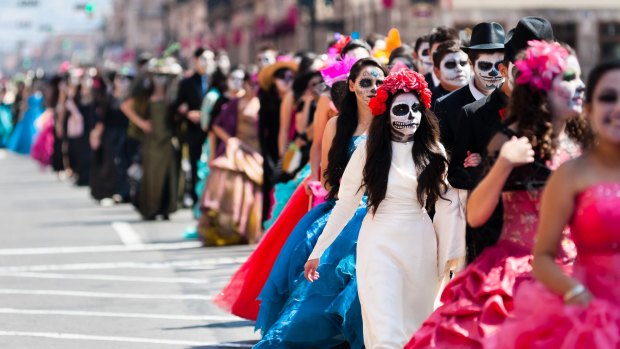
Credit: Alamy
This multi-day fiesta, held on October 31-November 2, celebrates family and friends who have died, to support them on their spiritual journey. Traditions include calaveras (sugar skulls), Aztec marigolds and parades.
DIA DE NUESTRA DE GUADALUPE
Celebrating the miracle of the Virgin of Guadalupe, who appeared to young indigenous Mexican Juan Diego in 1531, ordering him to ask a bishop to build a church in Mexico City. On December 12, pilgrims flock to the resulting Basilica, walking on their knees asking for miracles.
GUELAGUETZA FESTIVAL OAXACA
An annual folkloric festival held each July in Oaxaca, celebrating the diversities of culture and traditions in the region. Also called Lunes de Cerro, or Mondays on the Hill.
FESTIVAL DE SANTA CECELIA
A colourful mariachi festival held in Plaza Garibaldi in Mexico City (and elsewhere) on November 22, featuring more than 500 musicians celebrating the music of Mexico.
MEXICO INDEPENDENCE DAY
Mexicans celebrate their independence on September 16, marking the occasion with fireworks, music, food and shouts of "Viva Mexico!" The date celebrates the cry for independence, made by Miguel Hidalgo in 1810 to motivate people to rally against the Spanish.
BAD HOMBRES: PLACES IN MEXICO BEST AVOIDED
COLIMA
Once a quiet beachside sanctuary, this Pacific coastal state has recently seen the largest increase in organised crime homicides, recording a staggering 1232 murders in 2016 – a sixfold increase as violence between warring cartels escalates.
CHIHUAHUA
The US Travel Advisory warns tourists not to travel at night in this state, and exercise caution in the border town of Cuidad Juarez. Even the popular tourist destination of Copper Canyon is considered the domain of outlaws, with visitors advised to travel by train and use a trusted guide.
GUERRERO
Once the most glamorous destination for Americans, the resort of Acapulco has been torn apart by gang violence, with murdered bodies dumped in public places and tourists caught up in crossfire. In 2016, there were 2213 murders in this state alone, earning it the dubious honour as the second-most dangerous city in the world.
SONORA
This border state is considered a key region in the international drug and human trafficking trade, with visitors encouraged to travel only during daylight hours and to avoid the triangle between Nogales, Sonoyta and Caborca because of "illegal activity".
MICHOACAN
Considered a major corridor for drug traffickers and armed self-defence groups, caution is advised in parts of this central state, with visitors to the Monarch butterfly reserves advised to access them via Mexico State.
See smartraveller.com.au for more information and updates
Sign up for the Traveller Deals newsletter
Get exclusive travel deals delivered straight to your inbox. Sign up now.